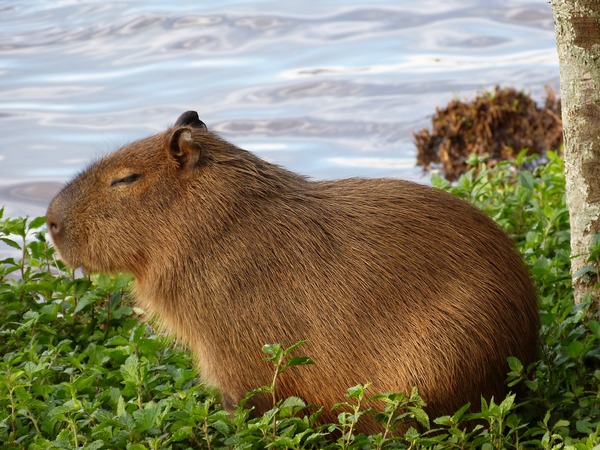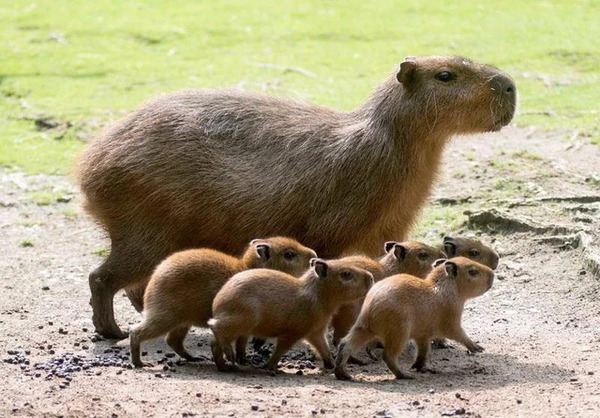When it comes to calm, social, and irresistibly cute animals, the capybara is in a league of its own. These giant rodents have stolen the hearts of millions, but there’s much more to them than meets the eye. Dive into this detailed guide about capybaras and discover why they’re nature’s chillest creatures.

Capybaras are the largest rodents in the world, weighing up to 150 pounds (68 kilograms) and measuring up to 4 feet (1.3 meters) long. Think of them as oversized guinea pigs with the temperament of a golden retriever. Native to South America, they’re found across a variety of wetlands, marshes, and grassy plains, often near water.
Water-Ready Bodies: Their webbed feet make them expert swimmers, and their dense fur keeps them warm, even in the water.
High-Set Eyes and Nostrils: These allow capybaras to stay submerged while keeping an eye out for predators.
Teeth That Never Stop Growing: Like other rodents, their teeth grow continuously, which is why they’re always grazing to keep them filed down.
Capybaras are perfectly adapted to their environments, which are predominantly tropical wetlands and riverbanks. Here’s how they thrive:
Semi-Aquatic Adaptations: Capybaras are fantastic swimmers and can stay submerged for up to five minutes to evade predators like jaguars and caimans.
Habitat Range: They’re found from the savannas of Venezuela to the lush forests of Brazil and even in parts of urban South America, where they’ve adapted to living near humans.
Plant Control: By grazing on aquatic vegetation, they prevent certain plants from overgrowing and choking water systems.
Seed Dispersal: Capybaras play a critical role in spreading seeds through their droppings, supporting plant diversity in their habitats.
Capybaras are herbivores with a diet that consists mainly of grasses, aquatic plants, and fruits.
Caecotrophy: Capybaras consume their own feces to extract the maximum nutrients from their plant-based diet. This process helps them break down cellulose and absorb essential vitamins.
Seasonal Diet: During the dry season, they’ll switch to eating bark and other tougher vegetation when grasses are scarce.

If there were a contest for the most sociable animal, capybaras would win hands down. They live in groups ranging from 10 to 20 individuals, though larger herds of up to 100 have been observed during the dry season.
Strong Bonds: Within a group, there’s usually a dominant male, females, subordinate males, and juveniles.
Communication: Capybaras use a variety of vocalizations, including barks (to signal danger), whistles, and purrs to communicate with one another.
Safety in Numbers: Group living provides protection from predators like anacondas, jaguars, and caimans.
Capybaras have evolved to be the ultimate survivors in their watery habitats:
Swimming Skills: They have webbed feet for propulsion and can even sleep in the water with their noses above the surface.
Thick Fur: Although not waterproof, their fur dries quickly, preventing them from getting too cold after a swim.
Rodent Ancestors: Capybaras evolved from smaller rodents millions of years ago, gradually adapting to a semi-aquatic lifestyle.

The relationship between humans and capybaras is complex:
In the Wild: They’re sometimes hunted for their meat and hide, which is used in making leather.
As Pets: While they’re legal to keep as pets in some countries, capybaras require a lot of care, including a water source and a social companion to avoid stress.
Urban Adaptation: In some regions, capybaras have learned to coexist with humans, often seen lounging in city parks and golf courses.
Capybaras are famous for their calm and friendly demeanor, which has earned them the title of the “world’s chillest animal.”
Group Living: Being part of a herd reduces stress and provides a sense of security.
Adaptable Nature: Capybaras are quick to adapt to their surroundings, whether in the wild or near humans.
Non-Aggressive Behavior: Unlike many animals, capybaras are rarely territorial, and they often form symbiotic relationships with other species, like birds that perch on them to eat insects.
Capybaras and Hot Springs: In Japan, capybaras are known to relax in hot springs during the winter, a behavior that has made them a tourist attraction.
Social Media Stars: From TikTok to Instagram, capybaras have become internet sensations for their chill vibes and photogenic looks.
Yes, but they require a lot of care, including access to a swimming area, a specific diet, and companionship (they get lonely easily).
Capybaras are famously tolerant and get along with birds, monkeys, and even some predators.
Not currently. Thanks to their wide range and adaptability, they’re listed as "Least Concern" by the IUCN, though habitat destruction could pose a future threat.
Capybaras (Hydrochoerus hydrochaeris) are the largest rodents in the world, living a semi-aquatic lifestyle in the wetlands and riversides of South America. While these gentle herbivores are not aggressive, their presence in the ecosystem makes them a critical prey species for various predators. This article explores the animals that eat capybaras, their habitats, survival strategies, and ecological significance.
Capybaras are a key link in the food chain, making them a target for several carnivorous predators.
Jaguars:
Jaguars (Panthera onca) are apex predators in the capybara’s habitat. These big cats rely on their stealth and powerful jaws to ambush capybaras, often targeting them at riverbanks. Jaguars are nocturnal hunters, which aligns with the capybara's twilight activity periods.
Caimans:
Caimans, particularly the black caiman (Melanosuchus niger), lurk in the waters where capybaras swim. As semi-aquatic mammals, capybaras frequently enter caimans' territory, increasing their vulnerability to attacks.
Anacondas:
Green anacondas (Eunectes murinus), one of the world's largest snakes, are opportunistic predators. They often lie in wait near water bodies, using their immense size and constriction ability to overpower capybaras.
Pumas and Other Cats:
Mountain lions (Puma concolor) and ocelots (Leopardus pardalis) are also known to prey on capybaras. These predators rely on speed and agility to chase or ambush their prey.
Harpy Eagles:
In some areas, harpy eagles (Harpia harpyja), one of the most powerful birds of prey, may target young or small capybaras. With their sharp talons and precise hunting techniques, these raptors are formidable threats.
Capybaras are not defenseless despite their position as prey animals. They have developed behavioral and physical traits that help them evade predators.
Group Living for Defense:
Capybaras often live in groups of 10 to 20 individuals, which provides safety in numbers. Group vigilance ensures early detection of predators, and when threatened, capybaras will scatter, confusing the attacker.
Semi-Aquatic Lifestyle:
Water is the capybara's ultimate escape route. They are excellent swimmers and can stay submerged for up to five minutes, often hiding from land predators like jaguars or pumas.
Camouflage and Alertness:
Their brownish fur blends well with the surrounding vegetation, offering a degree of camouflage. Capybaras also have a keen sense of smell and hearing, which helps them detect threats early.
Nocturnal and Crepuscular Activity:
By being most active at dawn and dusk, capybaras reduce the likelihood of encountering diurnal predators like harpy eagles or humans.
Understanding where capybaras live is essential for exploring their interactions with predators and the environment.
Natural Habitat:
Capybaras thrive in wetlands, savannas, and riverside habitats across South America, particularly in the Amazon rainforest. These regions provide abundant vegetation for grazing and water bodies for cooling off and escaping predators.
Trophic Levels and Ecosystem Role:
Capybaras are herbivores, feeding on grasses, aquatic plants, and fruits. As prey animals, they occupy a crucial role in the food web, supporting the survival of higher trophic-level predators like jaguars and caimans.
Biodiversity Hotspots:
Capybaras share their habitat with a wide range of wildlife, including alligators, birds of prey, and even humans in some areas. Their presence contributes to the balance of the ecosystem, supporting predators and scavengers alike.
The relationship between capybaras and their predators highlights the complexity of nature's food chains.
Hunting Strategies of Predators:
Jaguars use ambush tactics, often leaping onto their prey with precision.
Caimans lie in wait underwater, launching sudden attacks.
Anacondas rely on stealth and constriction to secure a meal.
Capybara's Role as Prey:
As a prey species, capybaras help maintain predator populations. The loss of capybaras in an ecosystem could disrupt food chains, leading to overpopulation of vegetation and declining predator numbers.
Threats Beyond Natural Predators:
Humans sometimes hunt capybaras for their meat or fur. In some areas, this has led to population declines, which can affect the overall ecosystem balance.
Capybaras are more than just adorable, oversized rodents; they play a vital role in their ecosystems. As prey animals, they support a diverse array of predators, including jaguars, caimans, and anacondas. Their survival strategies, such as group living and their semi-aquatic nature, showcase their adaptability and resilience.
By understanding the predators, habitats, and ecological significance of capybaras, we gain deeper insights into the delicate balance of nature and the importance of preserving these remarkable ecosystems. Whether in the Amazon rainforest or the wetlands of South America, capybaras remain a cornerstone of biodiversity and a testament to the interconnectedness of life.
Capybaras are not just the largest rodents on Earth—they’re also some of the most fascinating and chill animals you’ll ever encounter. Whether you’re intrigued by their social structures, aquatic adaptations, or their role in ecosystems, capybaras are a testament to the beauty and complexity of nature.
So next time you see a photo of a capybara lounging with a bird on its head, remember—there’s a lot more to these incredible creatures than their laid-back looks!
animal tags: Capybaras
We created this article in conjunction with AI technology, then made sure it was fact-checked and edited by a Animals Top editor.